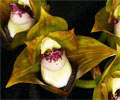|
|
|
|
 |
Email Address Recovery or Password Reset |
Use our Change Password page, and you can set a new password, or if you don't remember which email address you
registered with, the same page may be able to suggest it based on another you enter.
|
|
|
|
|
| |
Flasks of
Bifrenaria tetragona 'Whitten 3623' × self |
|
| |
|
|
| |
| Number: |
TN6590 |
| Name: |
Bifrenaria tetragona 'Whitten 3623' × self
|
| Type: |
self (What's that?) |
|
Click to Enlarge

Pod Parent Flower |
Click to Enlarge

Pod Parent Flower |
|
|
|
| |
For additional origin/habitat information supplied courtesy of
Charles and Margaret Baker, see further below, near the bottom of this page.
|
Temperatures we attempt to use in the lab & greenhouse:
| For Species: |
|
Spring, Summer, Autumn: days average 77°F, nights 63°F; best fit is Intermediate 83-60°F
(Source:
Baker's Web OSC) |
| For Species: |
|
Winter: days average 67°F, nights 54°F; best fit is Cool 70-52°F
(Source:
Baker's Web OSC) |
|
About the name...
| Etymology of |
Bifrenaria |
|
From Latin "bi" two, double; "frenum" bridle, brake. The 4 pollinia sit separated on two stems on the pollinarium.
(Source:
Mayr & Schmucker 1998) |
| Etymology of |
tetragona |
|
From latinized Greek "tetragonus" rectangular, square. Refering to the bulbs.
(Source:
Mayr & Schmucker 1998) |
| Pronunciation of |
Bifrenaria |
|
bif-re-NAH-ree-ah
(Source:
Hawkes 1978) |
| Pronunciation of |
tetragona |
|
tet-RAH-go-na
(Source:
Hawkes 1978) |
|
If you would like to direct someone to this web page, please copy and paste this URL into your email:
http://troymeyers.com/d?016590
| Flask Information |
| Availability: |
We have sold all of the flasks for this item. |
| You should: |
Consider getting individual plants or compots instead of a flask.
See if we have plants available in the greenhouse. |
| Yield Estimate: |
300 plants (based on flask surveys done 11/18/2009 through 03/07/2012)
|
| Plantlet Sizes: |
From many flasks 20 - 110 mm plants (based on flask surveys done 04/05/2010 through 03/07/2012)
From one most recently surveyed flask 20 - 30 mm (03/07/2012)
|
|
You might also want to:
|
View the seed assay for this item.
See if we have plants available in the greenhouse.
View items of the same species.
View items of the same genus.
|
| Ordering Information |
| You are not currently logged in. |
|
You must be a registered user and be logged in to reserve a flask or place a notification request. Please log in:
|
|
 |
Email Address Recovery or Password Reset |
Use our Change Password page, and you can set a new password, or if you don't remember which email address you
registered with, the same page may be able to suggest it based on another you enter.
|
|
|
|
|
|
|
|
| |
The origin/habitat information below is supplied courtesy of Charles and Margaret Baker
The following information is based on the name of the plant provided by the donor, and assumes that the name is correct. If the plant has been misidentified, then the following information may not be correct.
This text is copyrighted by the Bakers and may not be reproduced without permission.
ORIGIN/HABITAT: Brazil. This orchid is found in the states Rio de Janeiro,
MInas Gerais, São Paulo, Paraná, Santa Catarina, and Rio Grande do Sul.
Other than reports that it comes from mountain areas of the listed states,
few details of habitat location, type, and elevation have been recorded.
The McQueens (1993) report that these plants grow well in an intermediate
environment with moderately bright light and a dry winter rest. On the
other hand, Hawkes (1965) indicated this orchid requires intermediate to
warm conditions, although plants growing at even low elevations in Rio
Grande do Sul experience relatively cool winter temperatures. Armed with
this information, we have estimated habitat location and elevation.
Growers should use the resulting conditions with a great deal of caution,
however.
More about this information and the Bakers...
|
|
|
| |
|
|
|